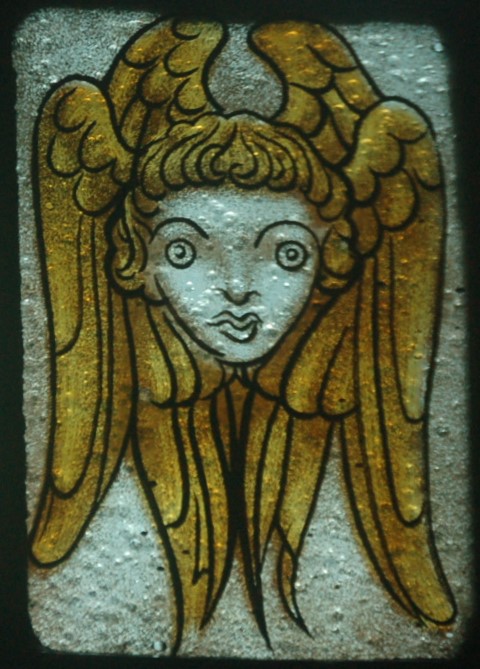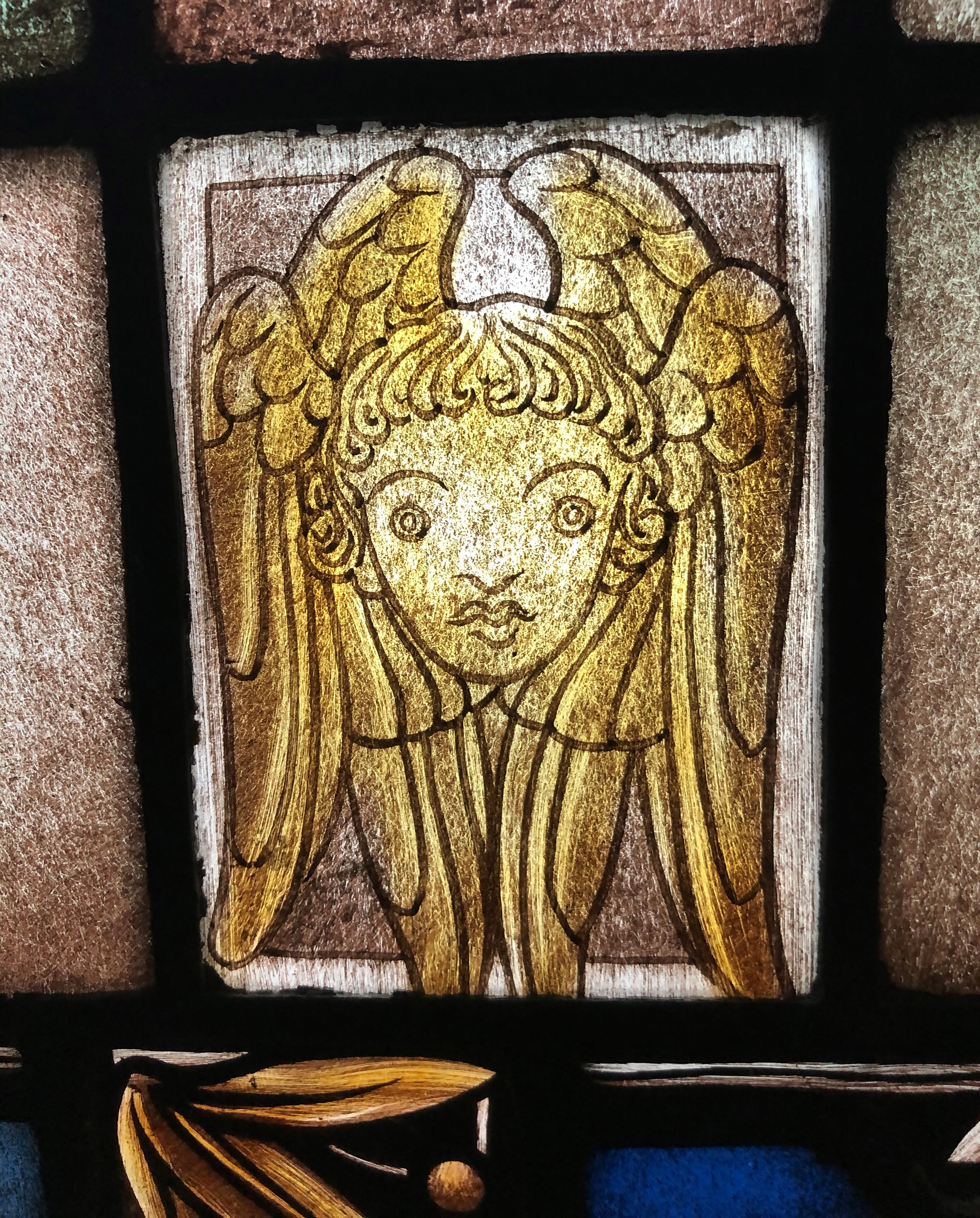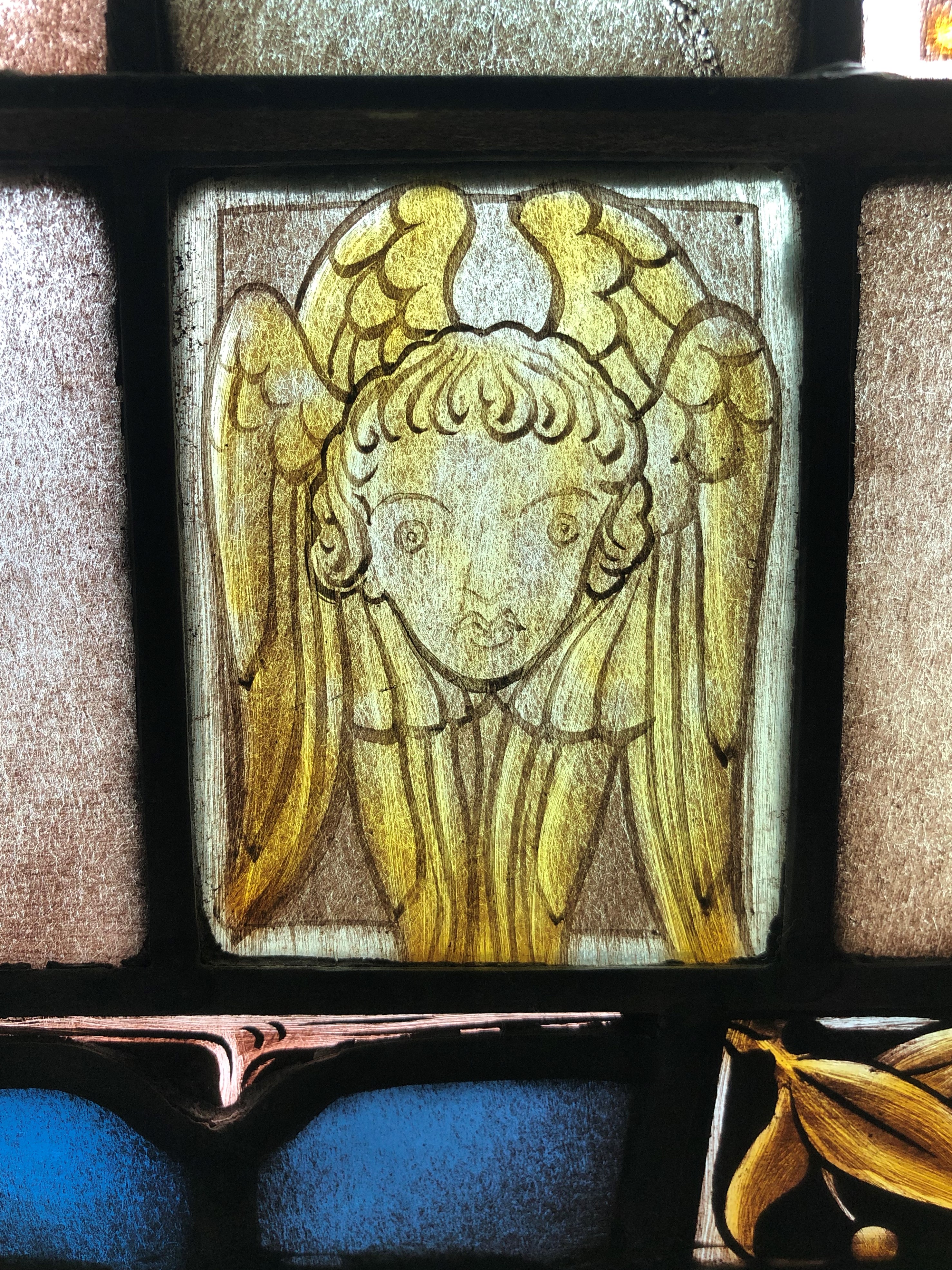By John Cleverdon, Foy Hannum, and Kathy Beckham; edited and updated by Molly Allison
Photo credit: Molly Allison
Note: Many of the terms used in this page may be unfamiliar. A good dictionary of terms used in The Episcopal Church is available here.
The featured image at the top of this page is the church’s cornerstone.
The architect of All Saints’ church was John Wetzel; the church was built in English Gothic style.
The building’s exterior is Mississippi limestone; the interior is brick and weathered oak.
The stained glass windows in the nave were made by J. Wippell & Co Ltd, of Exeter, England.
The reredos and the sanctuary windows are the work of the J&R Lamb Studios, then of Tenafly, New Jersey.
A guide for viewing the church
The symbols used in the windows and altar here are traditional, in most instances going back to the Middle Ages. The nimbus, or halo, is the sign of a saint, and the nimbus with a cross inside it indicates a member of the Trinity (God the Father, God the Son, God the Holy Spirit). The color of the Virgin Mary’s robe is most often blue, symbolizing the heavens; she often was depicted with the infant Christ on her lap, as the queen of heaven. Many of the traditional symbols used in Christian art are not Biblical, but grow out of apocryphal stories and legends. The best example of this is the treatment of the magi or wise men. The Bible does not mention their number, ages or rank. Legends tell that there were three and that they were kings. One is a youth, another middle-aged, and the third is an old man, thus representing the three ages of humankind. Legends also have them representing the three races. Thus the magi represent all humankind as they pay homage and present gifts to the Christ Child.
The Annunciation

The Annunciation window 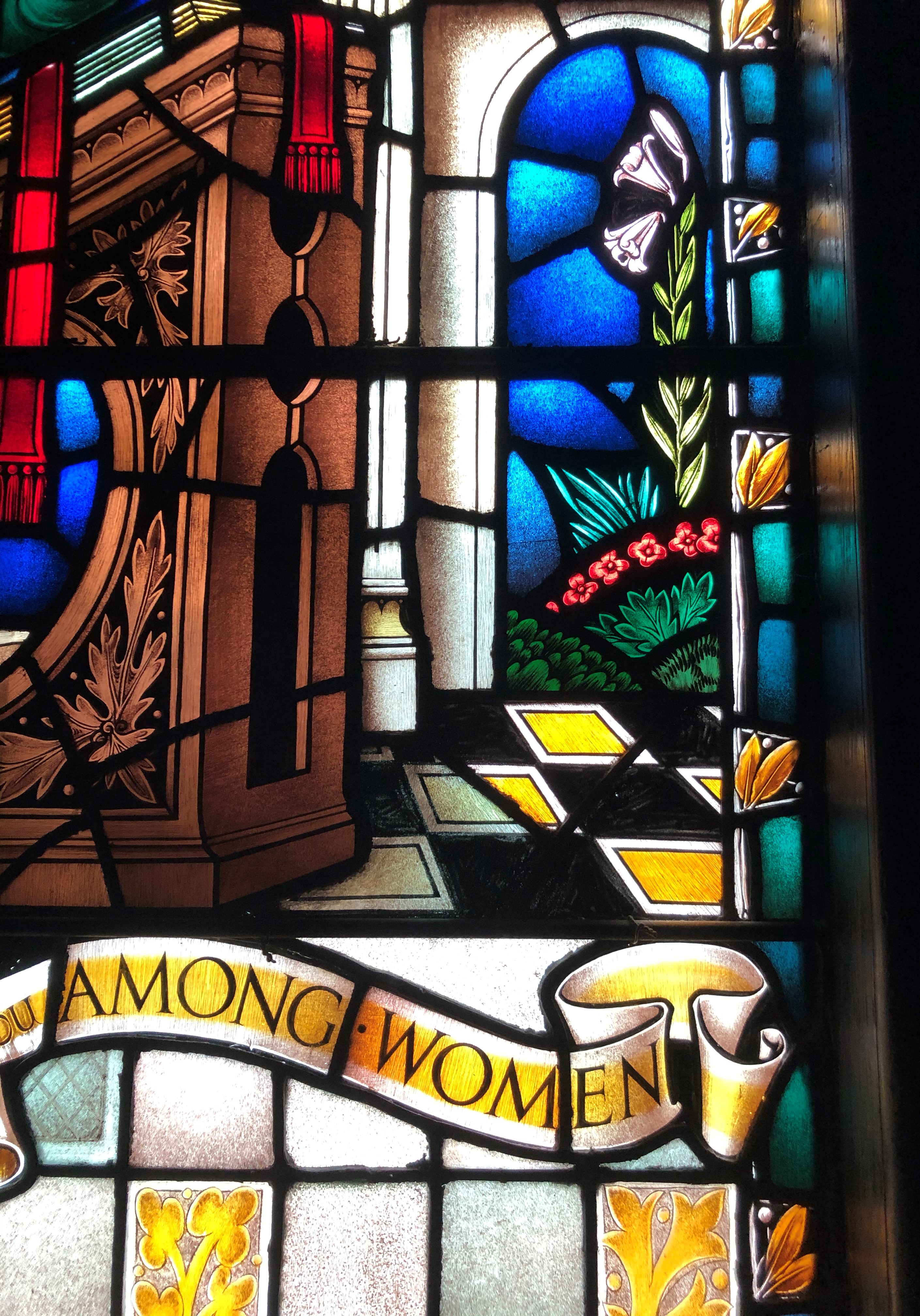
Symbols of Mary’s purity 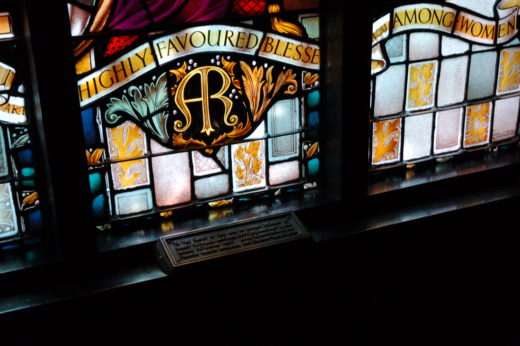
Maria, stylized 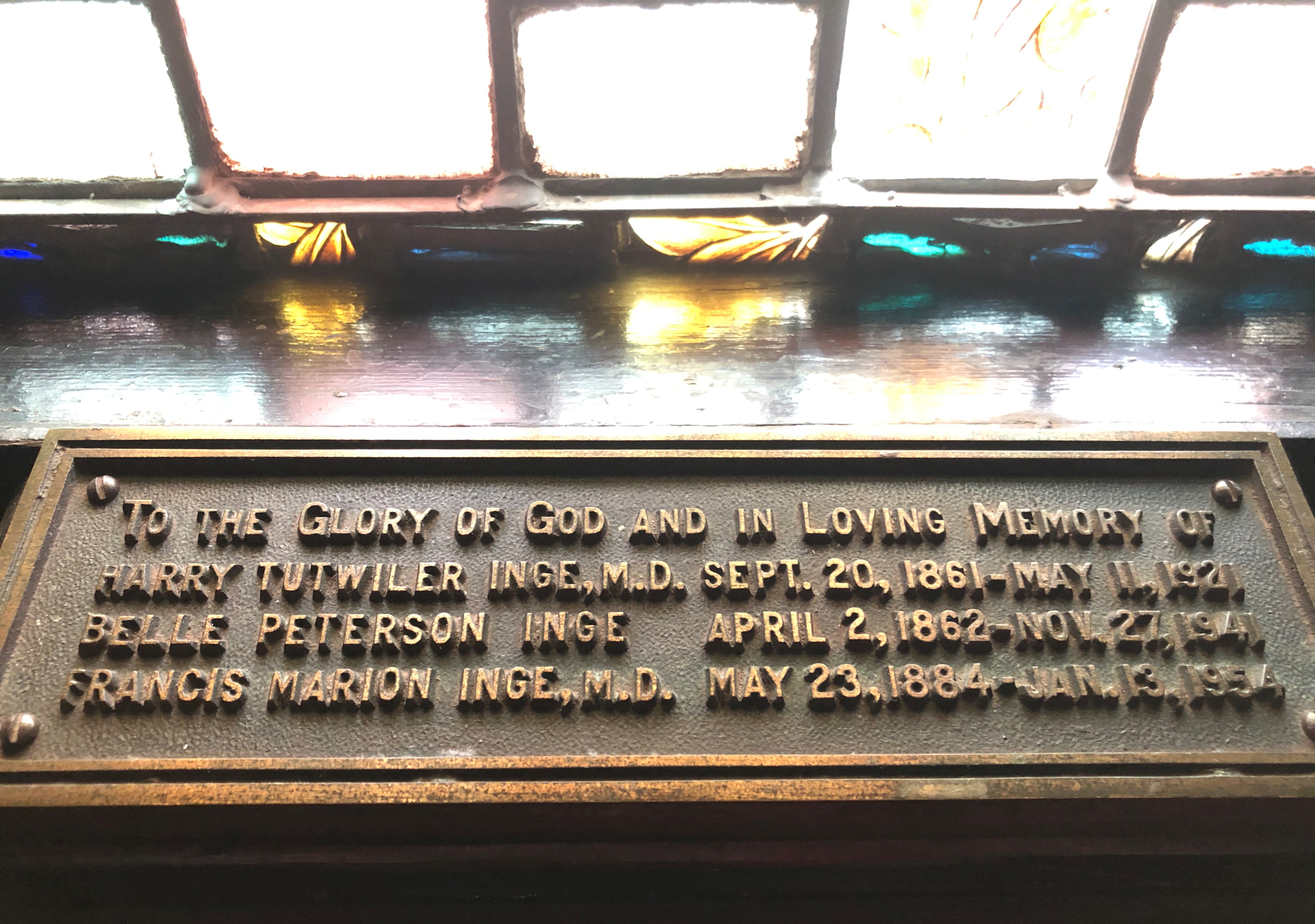
Annunciation window memorial plaque
The angel Gabriel appears to the Virgin Mary and announces that God has chosen her to bear God’s son. The scene is traditional – Mary seems to have been surprised while she was praying. The angel holds a scepter as the sign of his office as herald. The Easter lily, a sign of purity, and the other flowers denote the season of the year. In the liturgical calendar, the Annunciation occurs on March 25th. The dove with the divine nimbus symbolizes the Holy Spirit, and the rays of light that extend from him to Mary’s womb symbolize the moment of conception. In this window Mary wears purple, the royal color, as well as white, a sign of purity. Mary’s monogram is in the bottom of the window. It is simply a design made from the letters of her name in Latin, Maria.
Adoration of the Shepherds
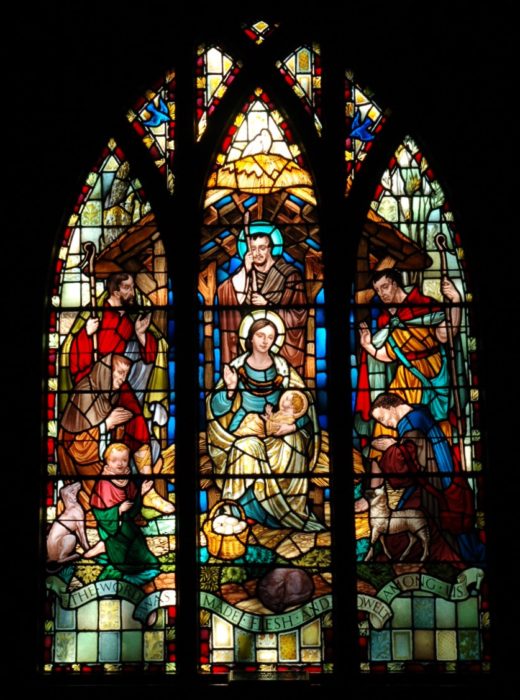
Adoration of the Shepherds 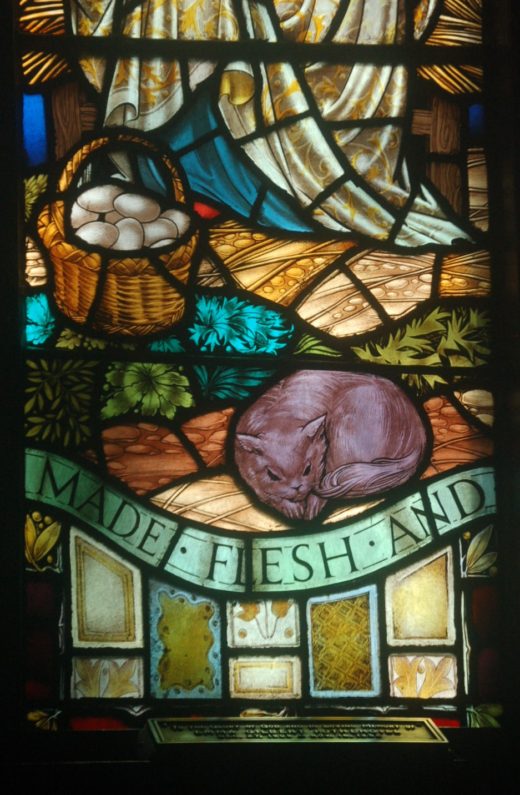
Eggs & cat 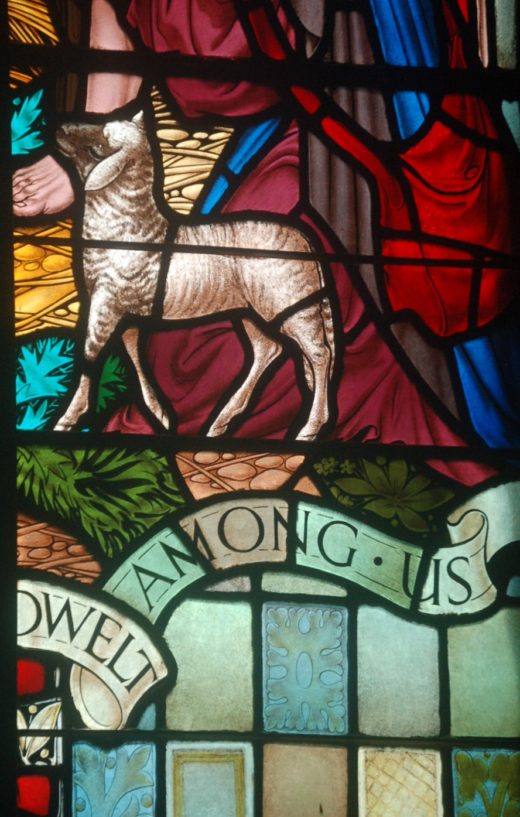
Little lamb, who made thee? 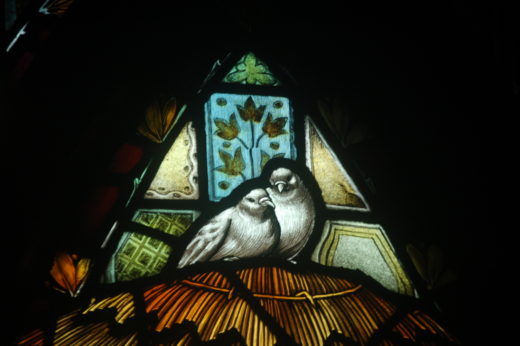
Doves 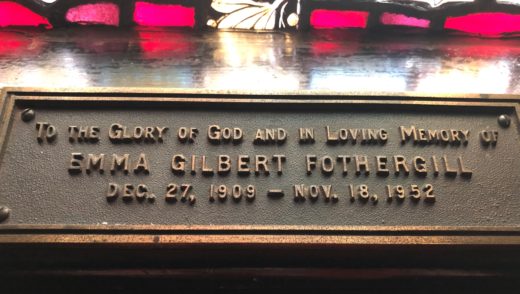
Shepherds window memorial plaque
The scene is rendered according to tradition, with the shepherds paying homage to the infant Christ. The only departure from tradition is the absence of the ox and the ass, or donkey. The manger is depicted as if it were a throne, and Mary sits on it as a queen, holding the Christ child. Traditional symbols associated with the animals are faithfulness (the dog), the church (sheep), Jesus as Lamb of God (the lamb), hope and resurrection (the eggs), and spirituality (the birds). The cat is without symbolic meaning in this scene, since cats may represent laziness and traditionally were associated with witches. Here it must be a realistic touch – no stable would be without a cat to catch mice.
Adoration of the Magi
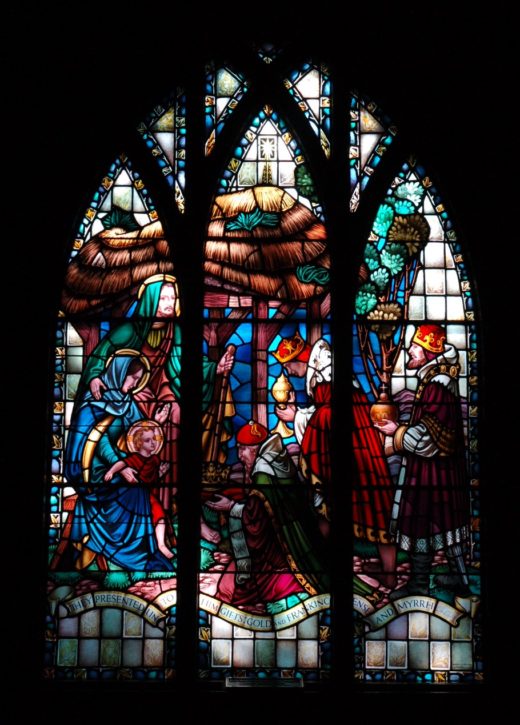
Adoration of the Magi 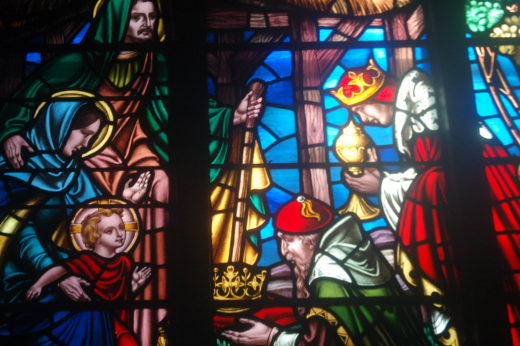
Gifts close-up 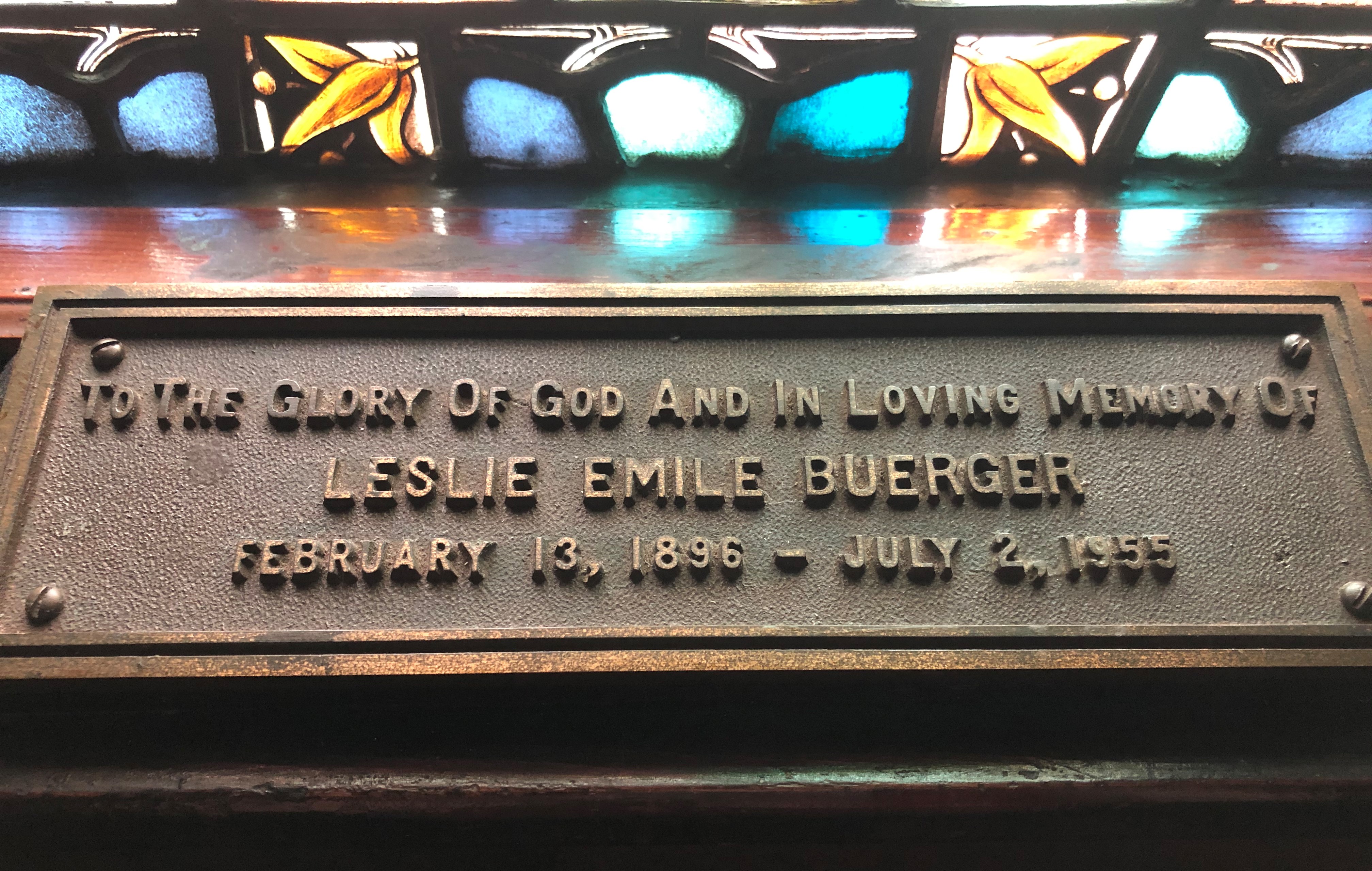
Magi window memorial plaque
The scene is traditionally shown, except the Christ child is older than usual, and the ox and the ass are again absent. The gifts presented by the Magi are gold, frankincense, and myrrh. Gold, in this instance shown as a crown, represents royalty, Christ’s kingship. Frankincense is incense that was burned in the temple as part of the worship, thus symbolizing Christ’s divinity. Myrrh was a spice used in preparing bodies for burial, here referring to the eventual passion and crucifixion. The Christ child wears red, the color of martyrs. Mary’s veil symbolizes her humility.
Christ Among the Doctors
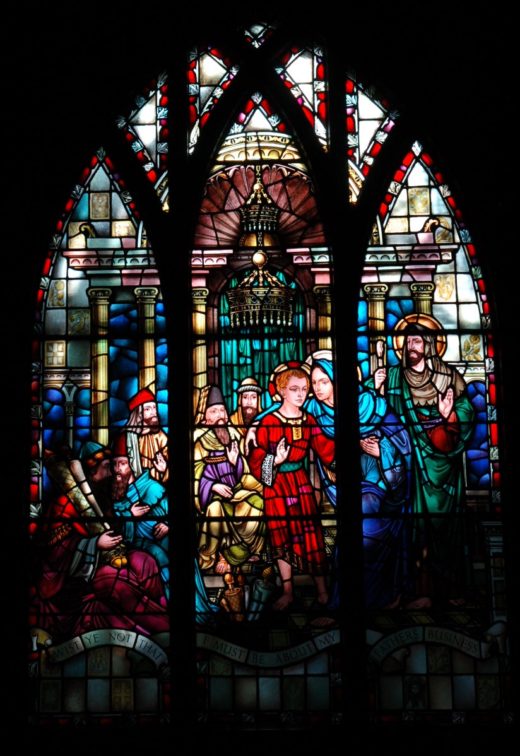
Christ Among the Doctors 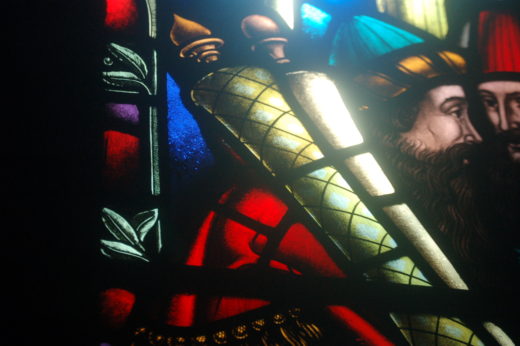
Scrolls of Hebrew texts 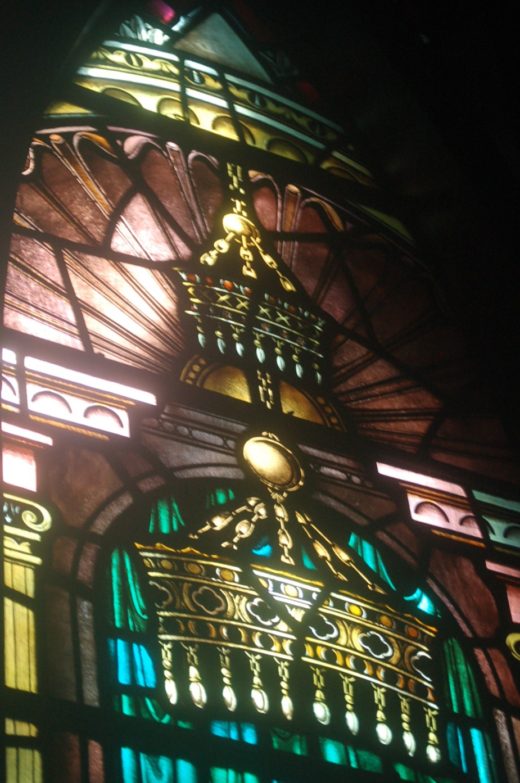
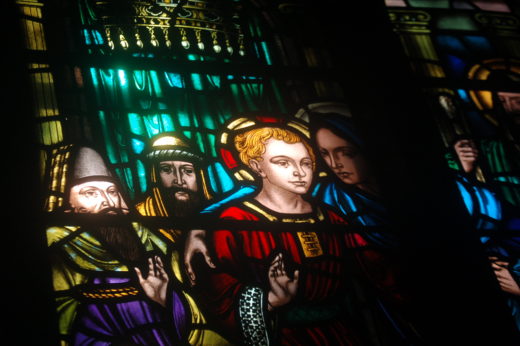
Mary finding Jesus 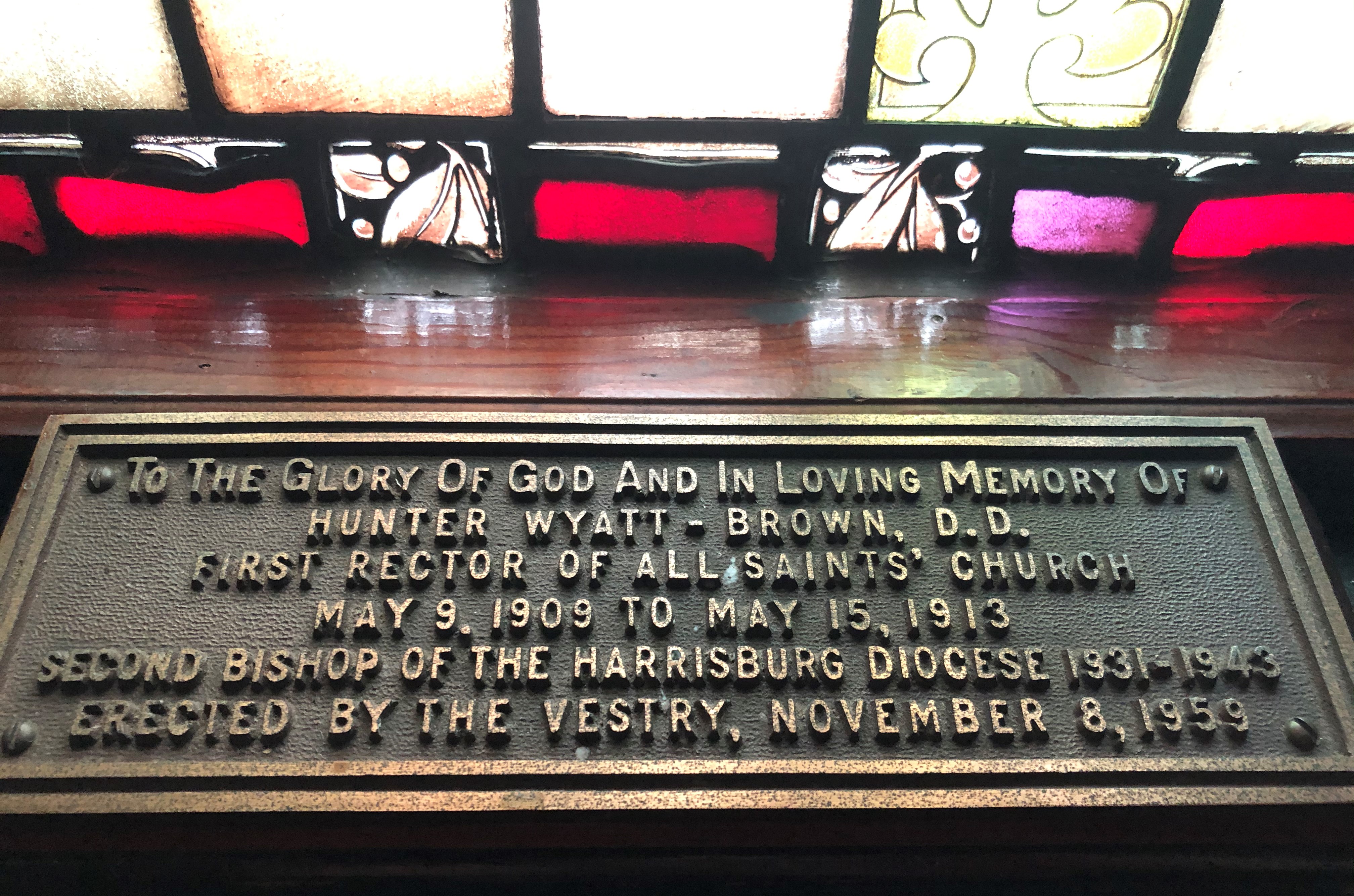
Temple window memorial plaque
The subject of this window is not often depicted in Christian art, since it is not part of the liturgical calendar. The scene is of the twelve-year-old Jesus, having been left behind by his parents when they had gone up to Jerusalem from Nazareth to worship at the temple, discussing the scriptures with the learned scholars. Mary and Joseph come upon the scene, having discovered the boy’s absence. The men’s heads are covered as in Jewish religious practice. The scrolls are the Old Testament scriptures. The curtains and the chandeliers indicate the temple with its veil. The subject is the only Biblical story of Jesus’ boyhood.
The memorial plaque below this window is dedicated to All Saints’ first rector, the Reverend Hunter Wyatt-Brown.
The Baptism of Christ
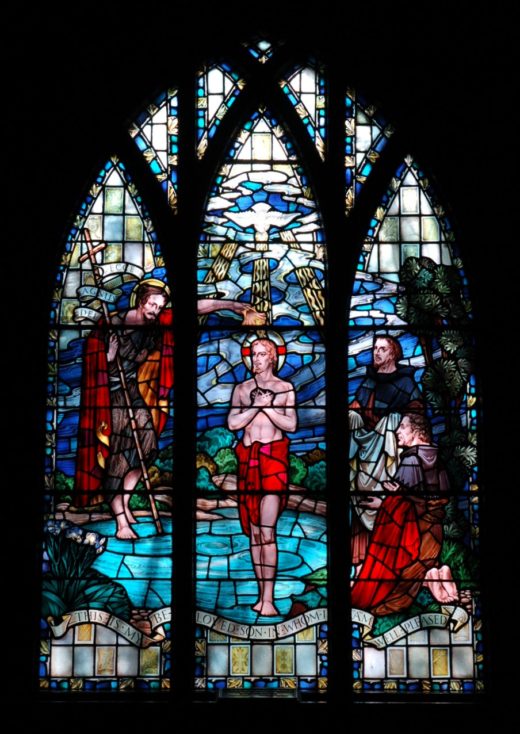
The Baptism of Christ 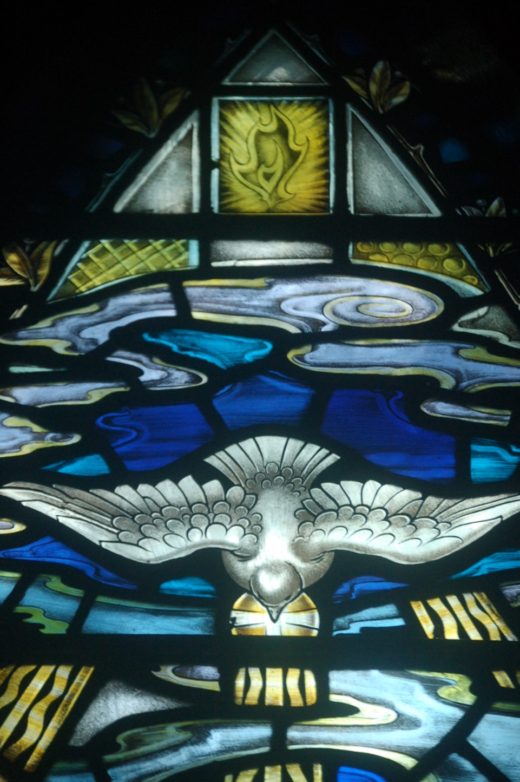
Holy Spirit like a dove 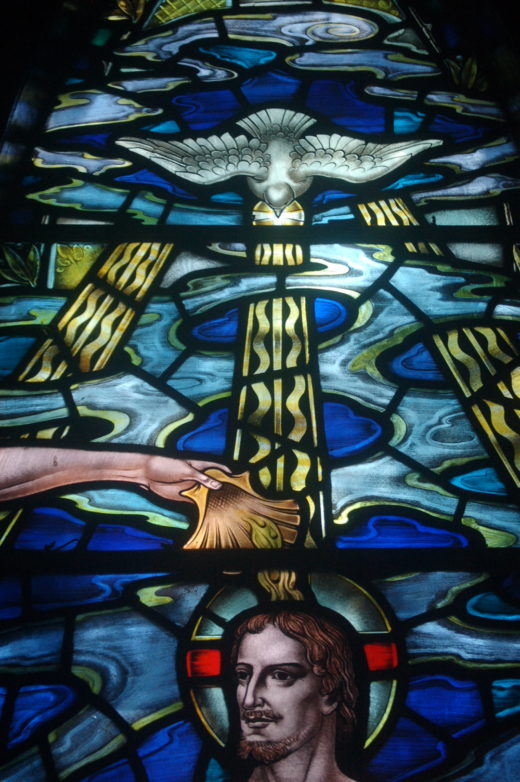
Baptizing with scallop shell 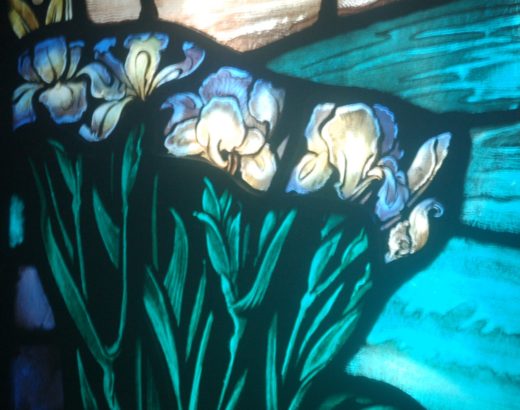
Irises at the waterfront 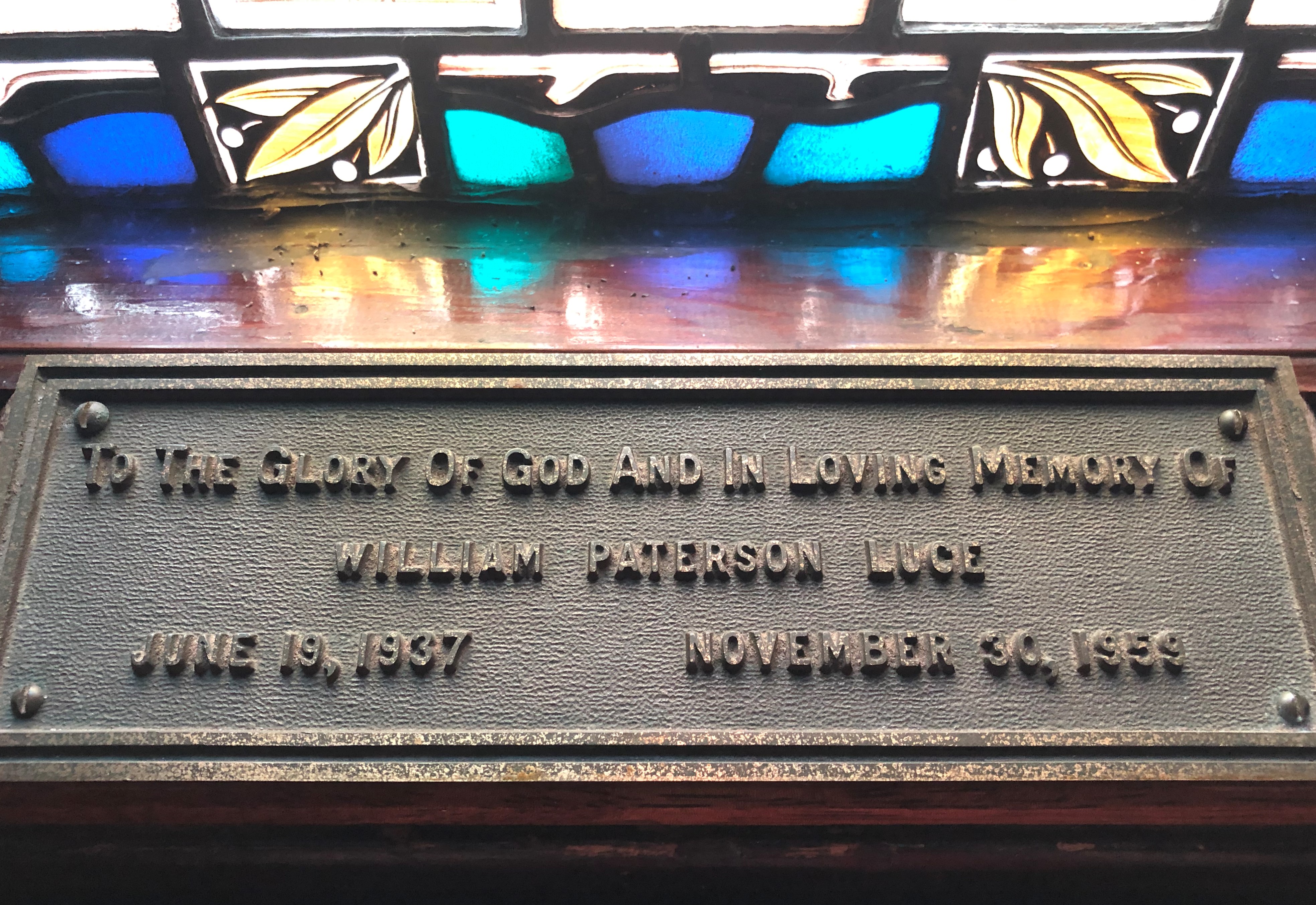
Baptism window memorial plaque
The treatment is traditional. John the Baptist baptizes Jesus by pouring water over his head from a scallop shell. As told in the biblical accounts, the Holy Spirit is described as being like a dove; notice the flame-like detail above the dove, hinting at the events of Pentecost depicted later in the gospels. The divine nimbus makes clear that this is God the Holy Spirit. John the Baptist holds his traditional banner with a reed cross and the words in Latin that mean “Behold the Lamb of God.” These are the words he says upon seeing Jesus approach him for baptism.
The Calling of the Disciples
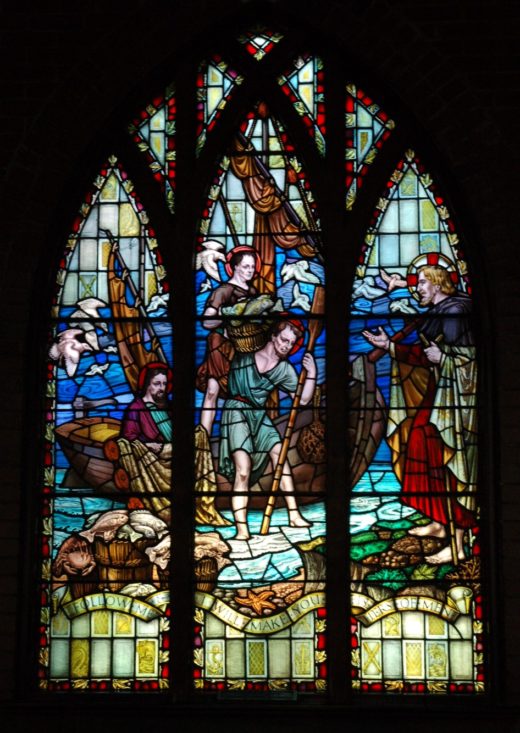
Calling of the Disciples 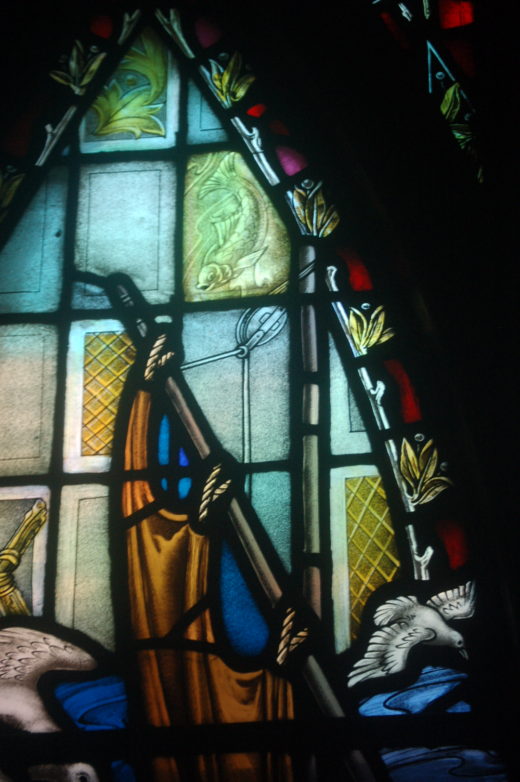
Sail & fish emblem 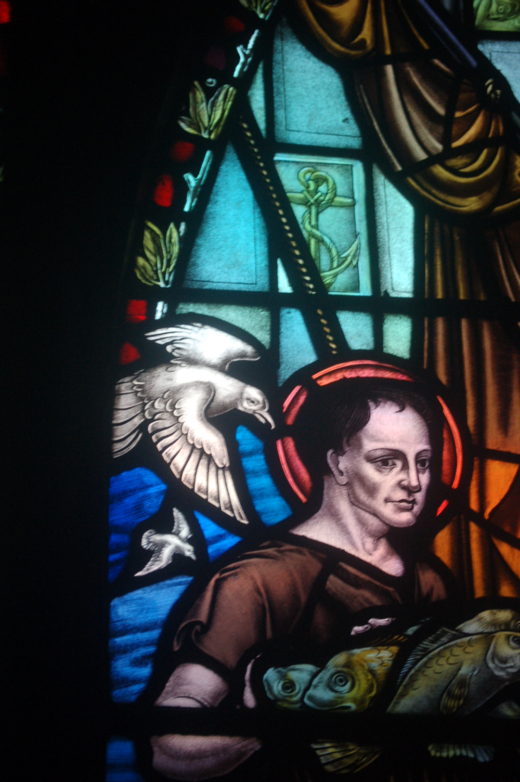
Seagulls & anchor emblem 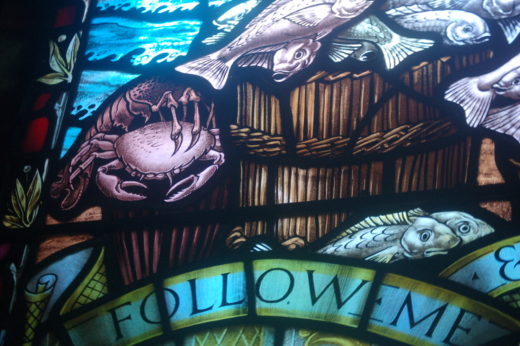
Fishermen’s baskets 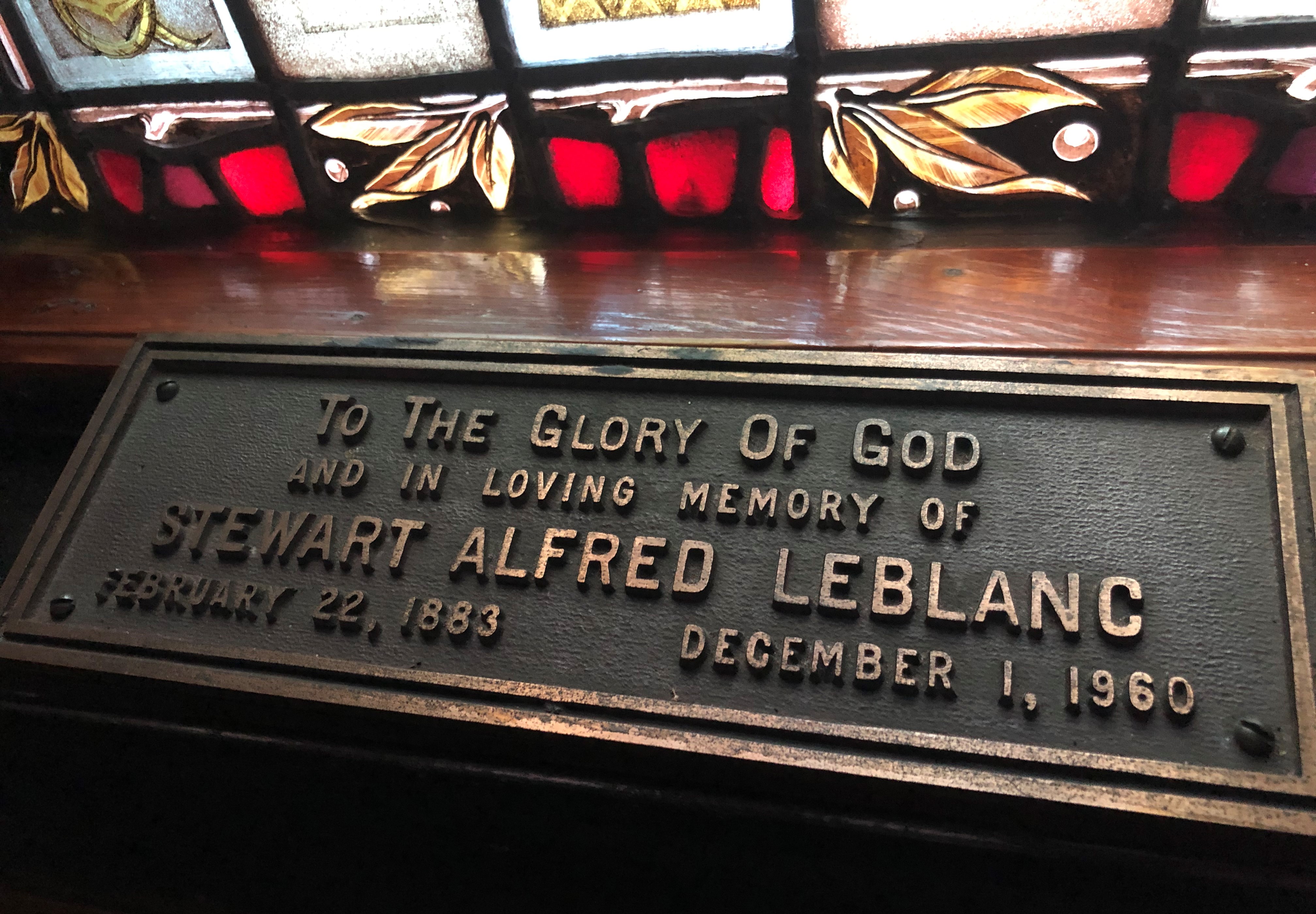
Disciples window memorial plaque
This scene is not often represented in religious art, since it is not included in the liturgical calendar. Therefore there is little traditional symbolism contained in it. Of special interest are the realistic and charming details of fish, crab, starfish and nets.
The Crucifixion
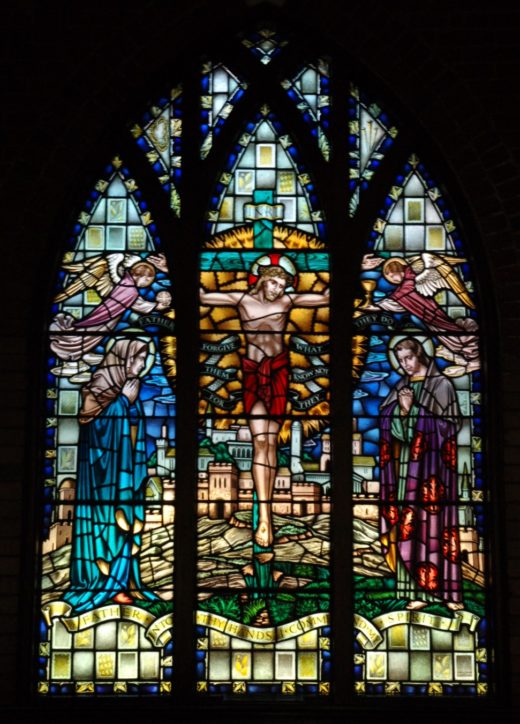
The Crucifixion 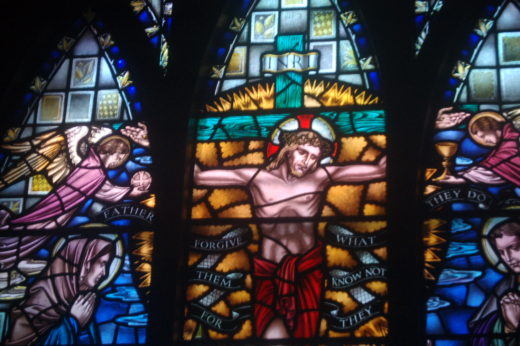
Father, forgive them, for they know not what they do 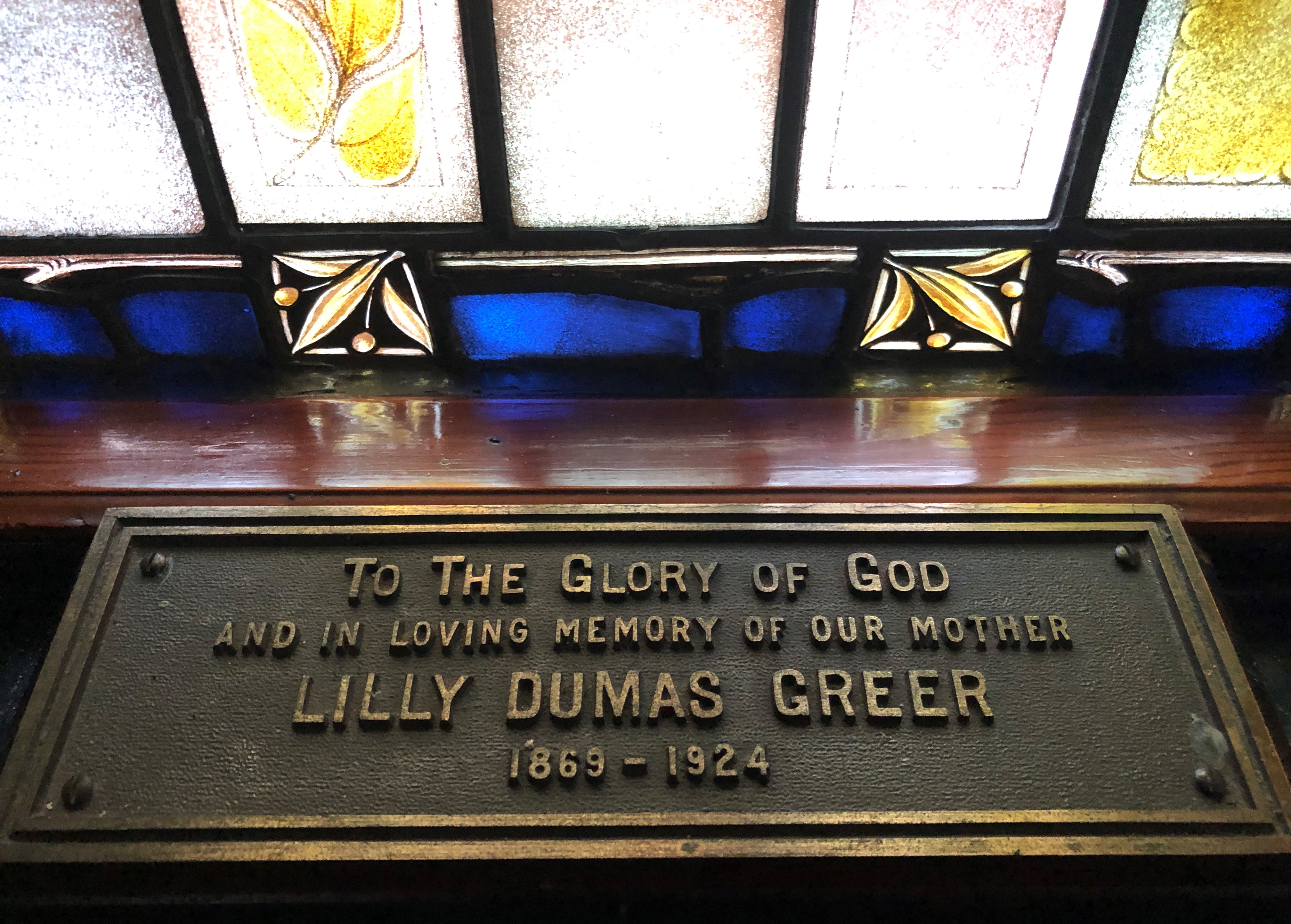
Crucifixion window memorial plaque
This window holds another traditional scene, with the Virgin Mary at Christ’s right and St. John, the beloved disciple, at his left. In medieval art Mary also symbolizes the Christian church, therefore holding the place of honor at Christ’s right, while St. John stands for the Jewish synagogue. Most of this meaning has been forgotten, and its origin is somewhat strained. One of the gospel accounts of events after the resurrection has the disciples rushing to the site of the tomb. John, being the fastest runner, gets there first. Instead of going into the cave, he waits and allows Peter to go in first. Peter, the first pope, symbolizes the church. The medieval theologians reasoned that John gave way to Peter in the same way that the synagogue gave way to the church. Thus, in the scenes of the crucifixion, St. John symbolizes the synagogue, and St. Mary becomes symbolic of the church. Other symbols in the window include the crown of thorns, Christ’s triumph and royal status, and the letters INRI, which are the initial letters of the title in Latin, “Jesus of Nazareth, King of the Jews.” In Latin, “I” and “J” were the same; “rex” is the word for king. Ministering angels bear the chalice and host of the Eucharist.
The Resurrection
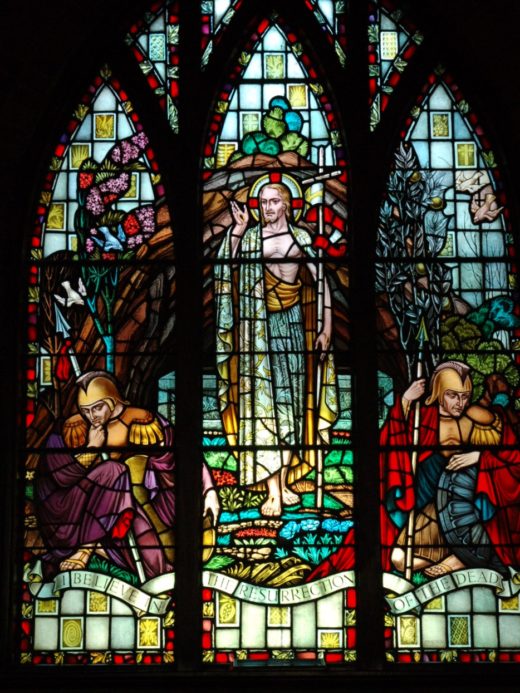
The Resurrection of Jesus 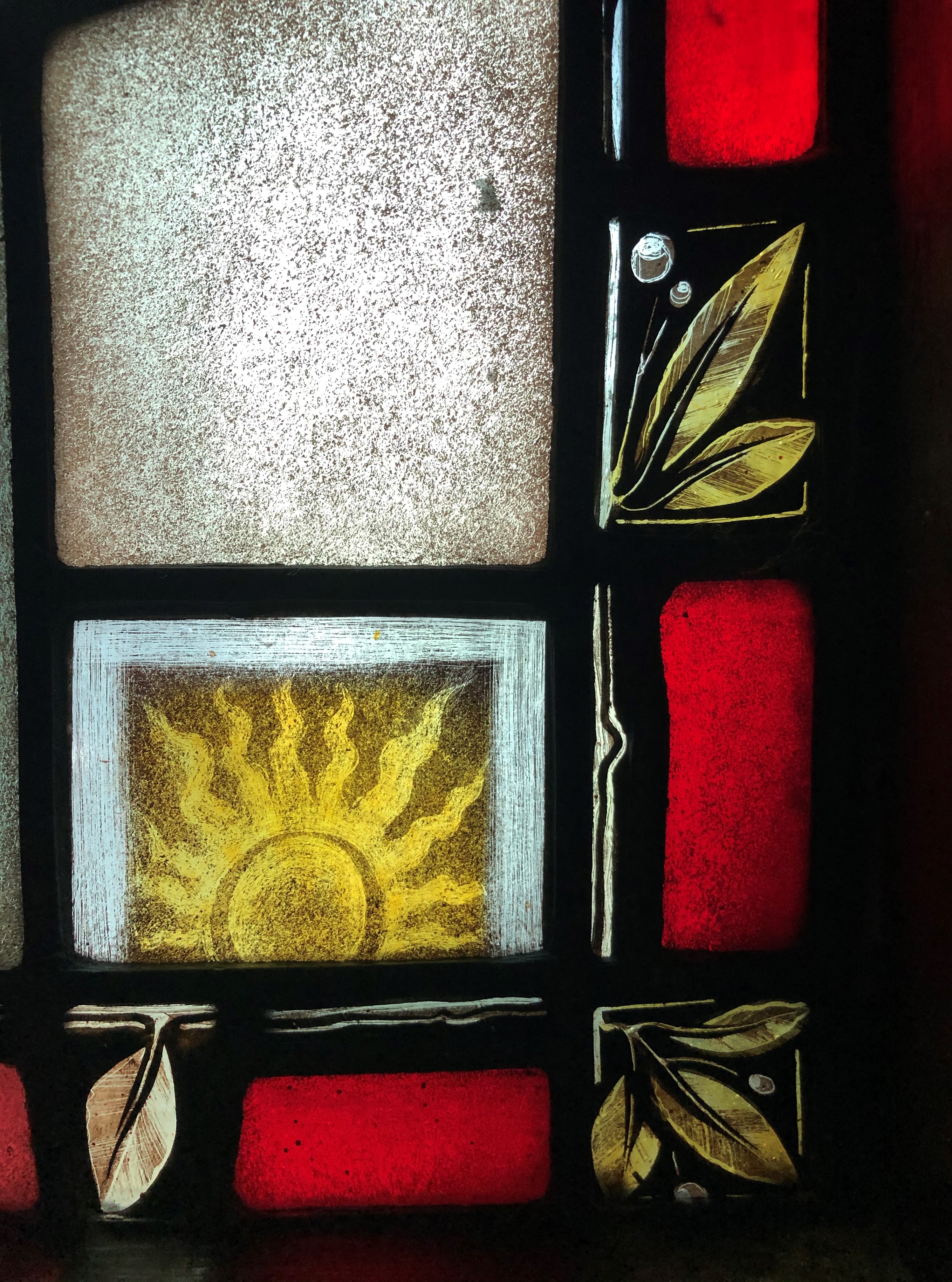
Rising sun 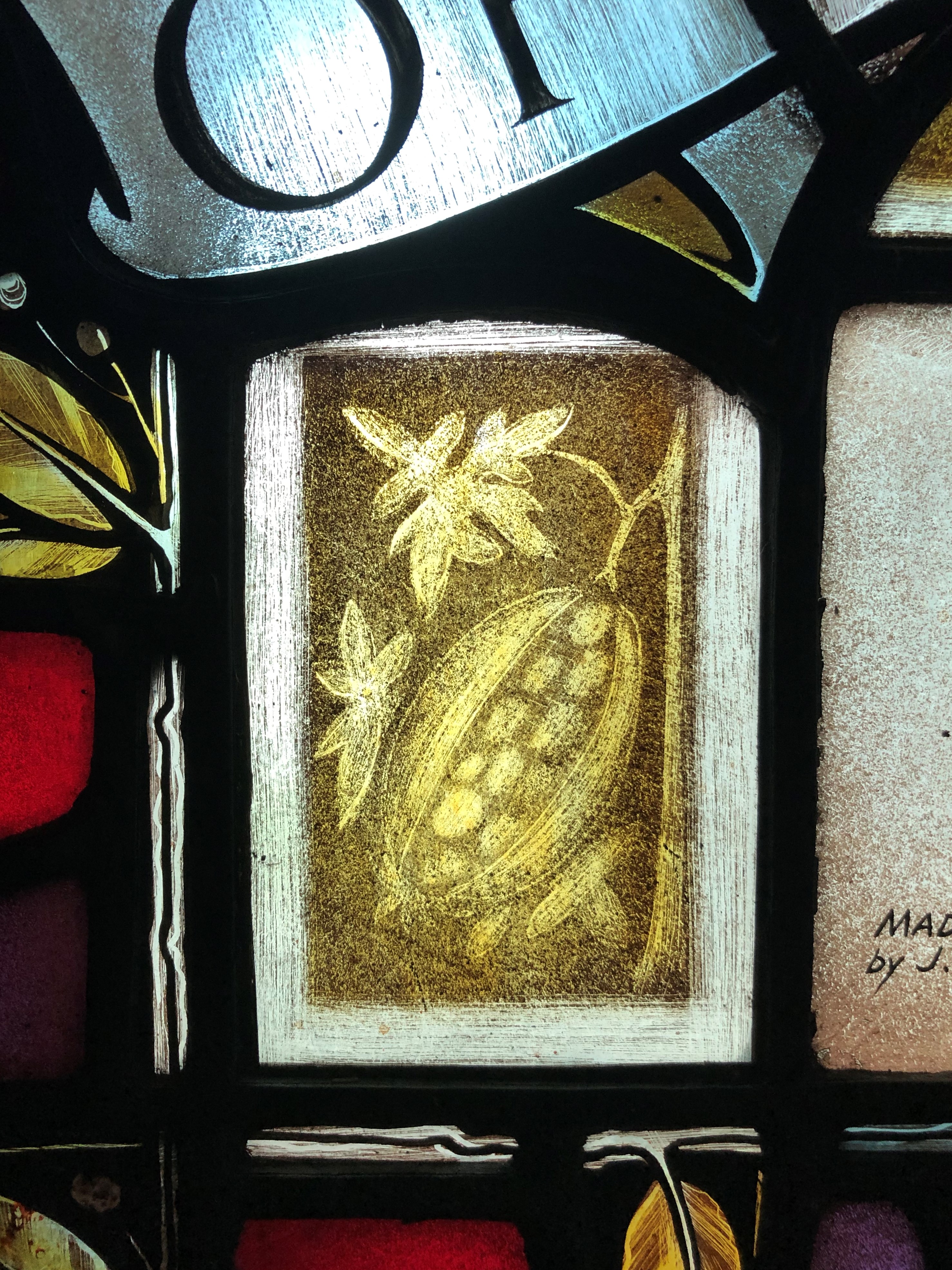
Pomegranate 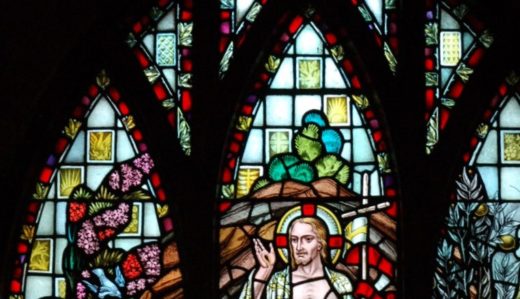
Resurrection symbols & the seasons 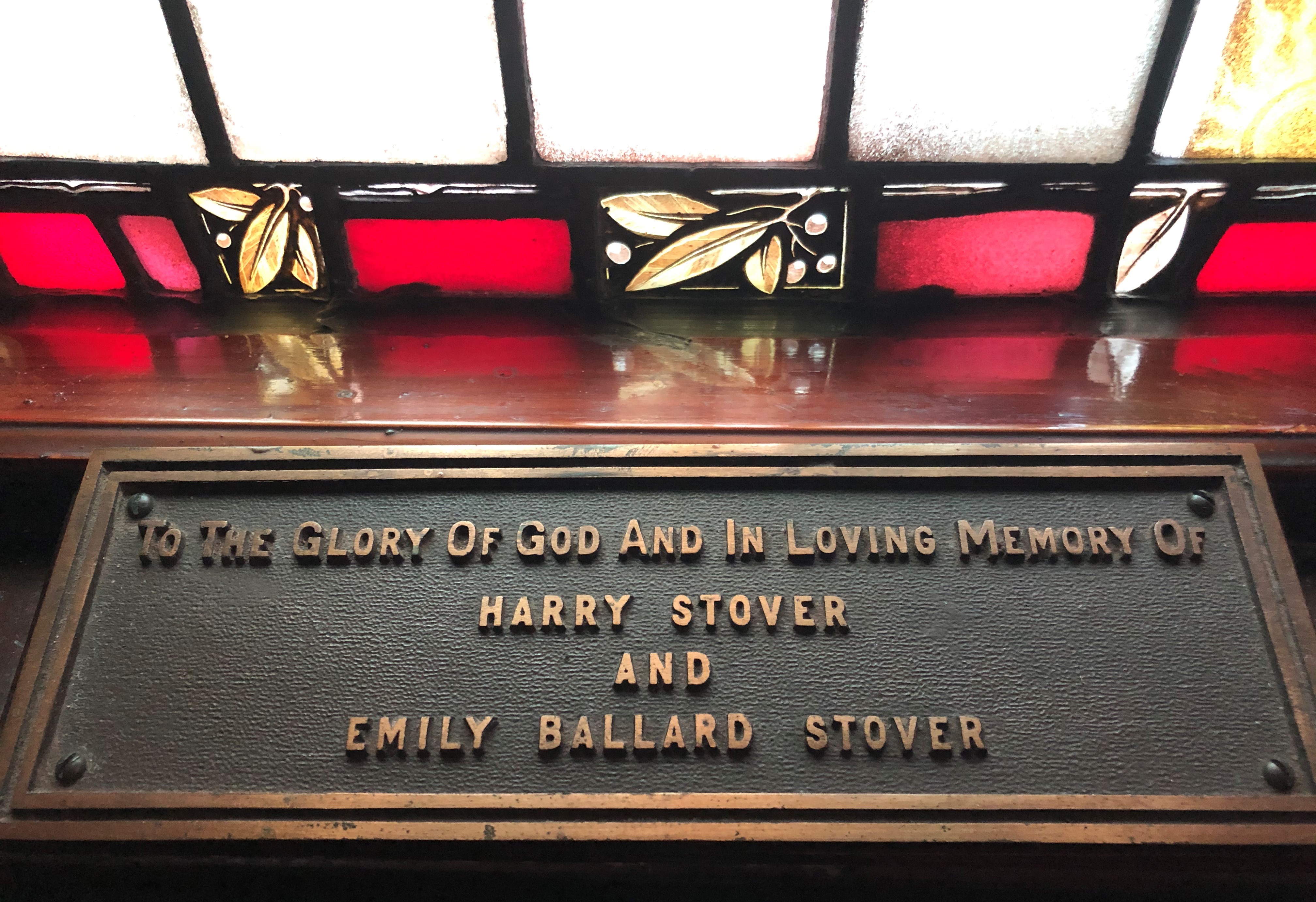
Resurrection window memorial plaque
The scene is depicted according to traditional art. Christ holds the Easter banner, a symbol of his resurrection. He wears white, the color of purity and also the color of the liturgical season. The trees show different stages – flowers, fruit, and bare branches symbolizing the seasons of the year. The sleeping soldiers, empty tomb, marks of the nails in Christ’s hands and feet are all traditional details. The small details of this window depict several historical symbols of resurrection: a rising sun; a pomegranate fruit; a phoenix, the latter two of these symbols originating from Greek mythology.
Pentecost
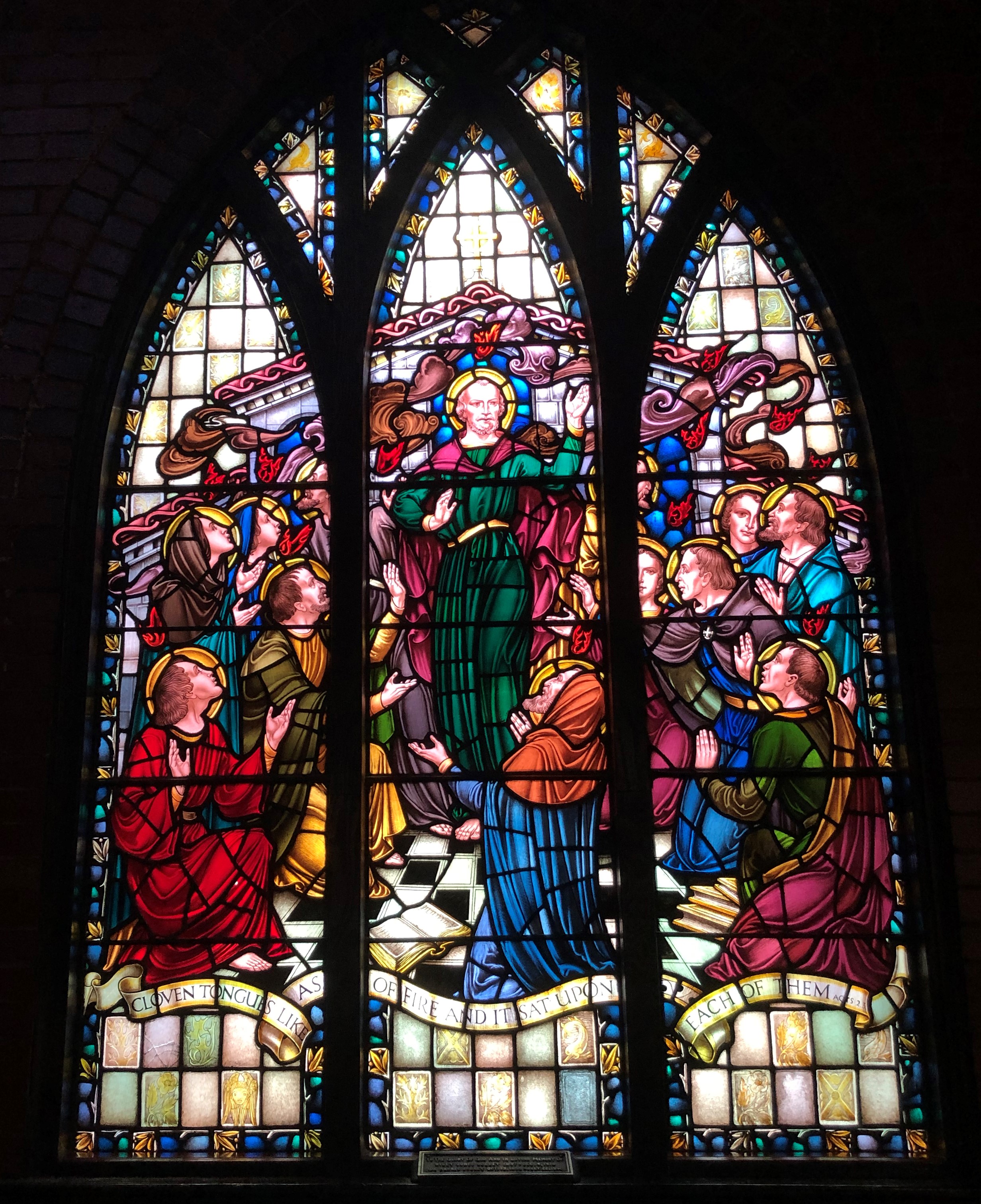
Pentecost 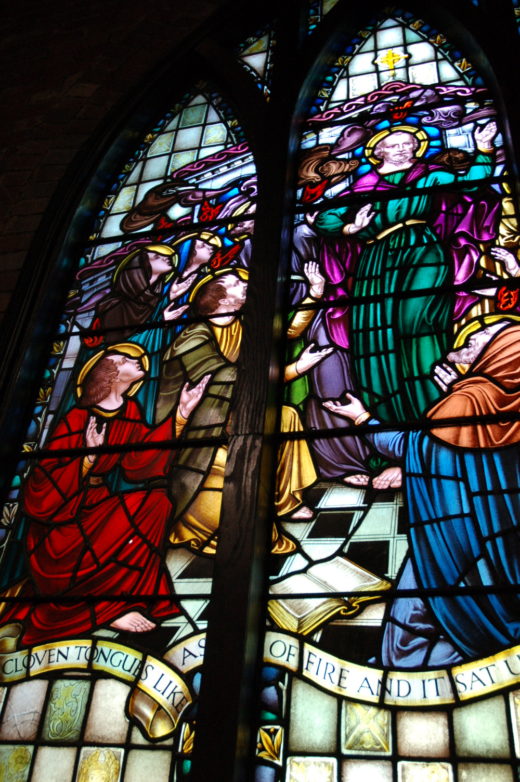
Tongues like as of fire 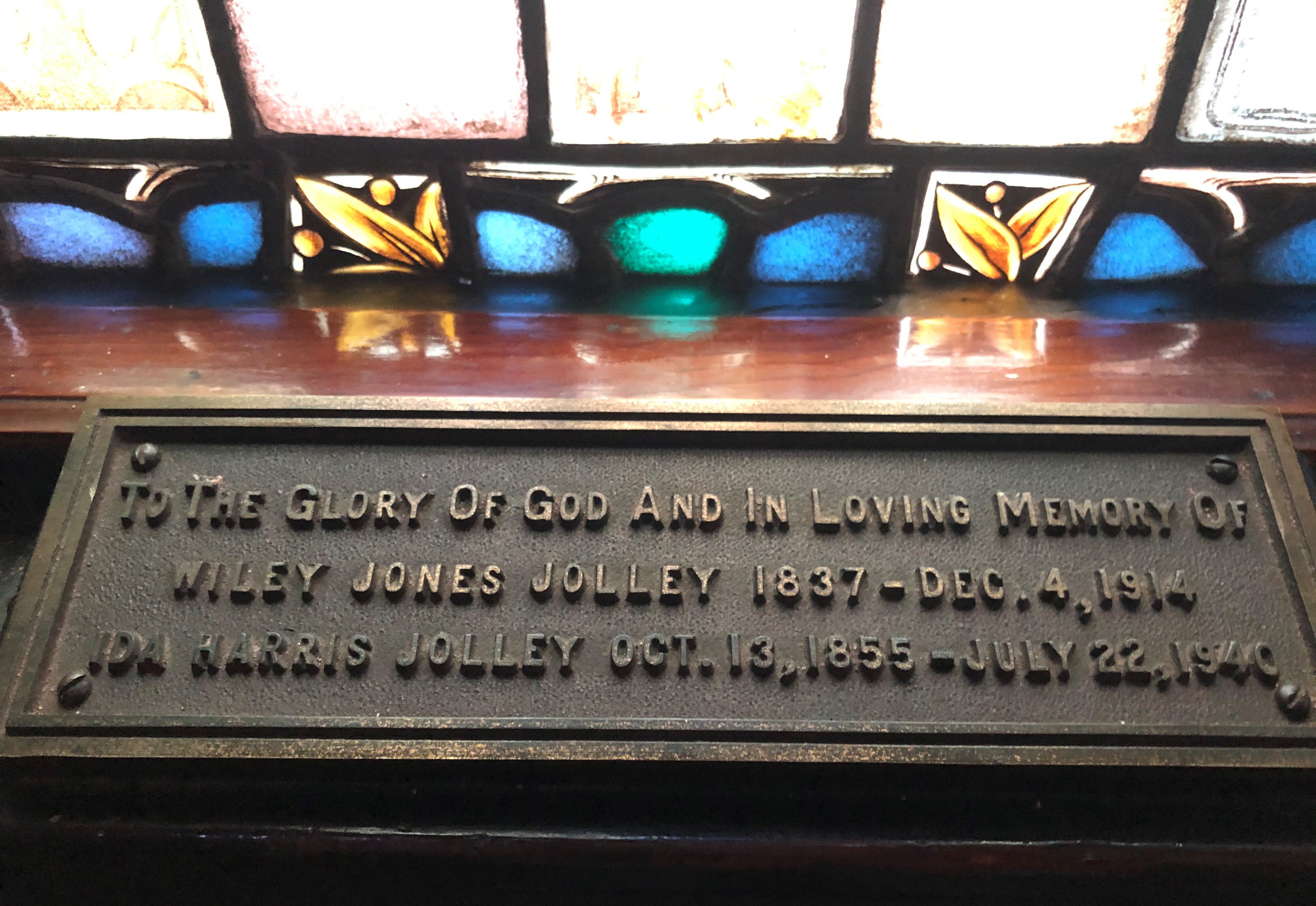
Pentecost window memorial plaque
This window shows the beginning of the Christian church. According to the biblical account, the Holy Spirit descended upon the apostles and they spoke in tongues (other languages). In the account, spectators heard the apostles speak in his or her own language. The gifts of the Spirit were described as being like tongues of fire. The figures represented are the Virgin Mary, the eleven original apostles, and Matthias, the person selected to replace Judas.
The Ascension
(shown not in a window, but in the hand-carved wooden reredos in back of the altar)
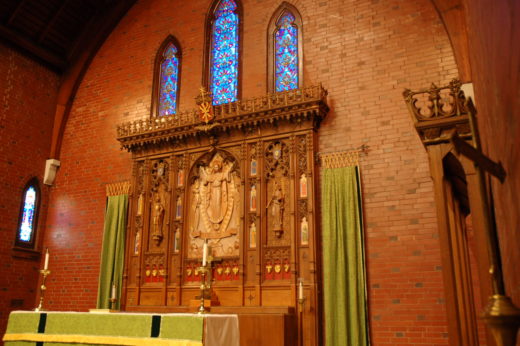
The sanctuary/altar area with carved reredos 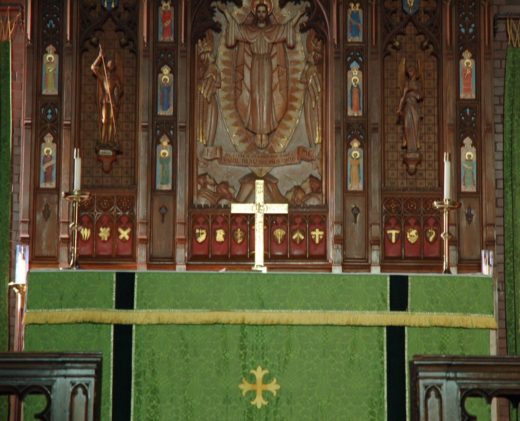
Reredos & altar 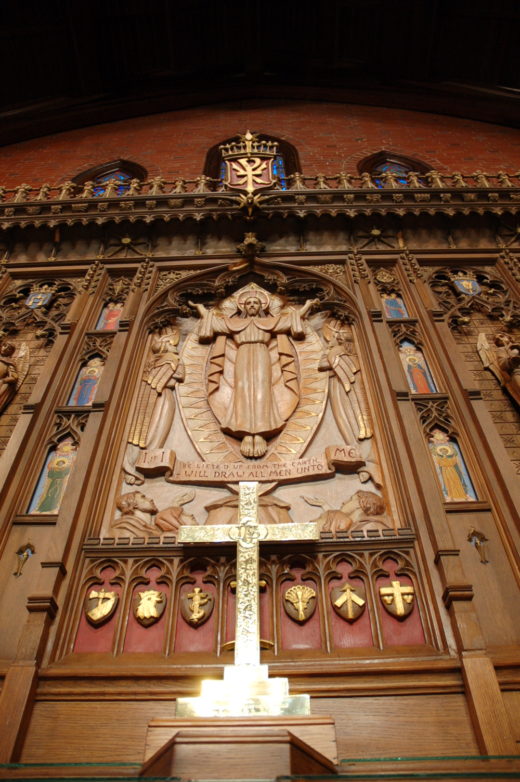
Center of the reredos 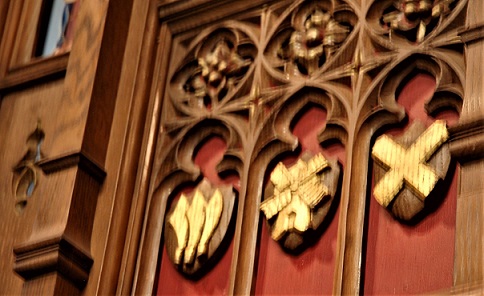
Apostle symbols left 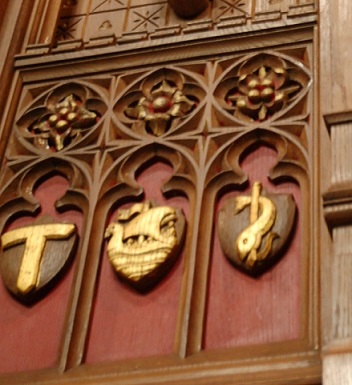
Apostle symbols right
The reredos is quite elaborate and full of symbolism. There are three panels. In the center is the figure of the risen Christ shown ascending into heaven. Behind him is a nimbus, like a halo, indicating his glory. Beneath his feet is a stump, representing earth, and around the stump, looking up, are clustered four disciples, two men and two women. Above Jesus and all across the top of the reredos is a canopy. In the center and above the canopy are a shield and crown, representing God the Father. Below the shield is the figure of a dove with outstretched wings as though in descent, representing the Holy Spirit. In the panel on the Epistle side of Christ is the figure of the angel Gabriel with his trumpet. Above Gabriel are three stalks of wheat, representing the last judgment. In the opposite panel, on the Gospel side, is the figure of the angel Michael with a sword. Under his feet is the figure of the dragon, and above his head is a representation of scales, symbolic of the last judgment. In the borders on either side of the reredos are smaller figures of angels, each with an instrument of music. Across the bottom of the reredos painted in gold against a red background are the symbols of the twelve Apostles.
Above the reredos is a three-panel window, showing the Tree Of Life as a vine winding through the windows.
The Trinity and the Evangelists
(window over the north-facing door)
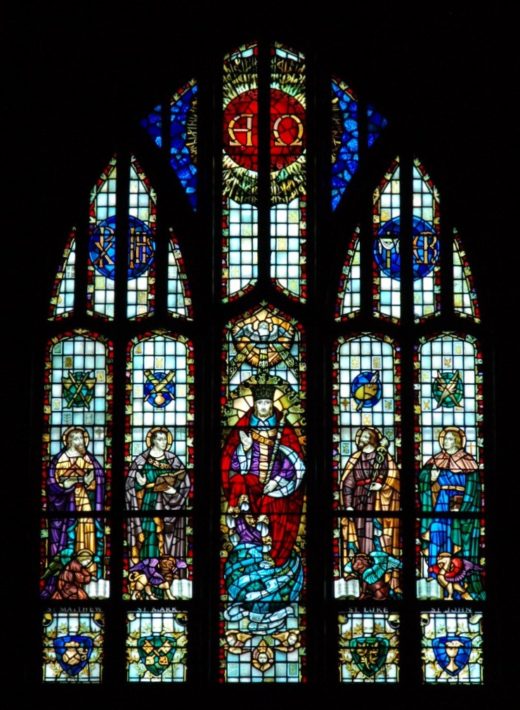
The Trinity and the Evangelists 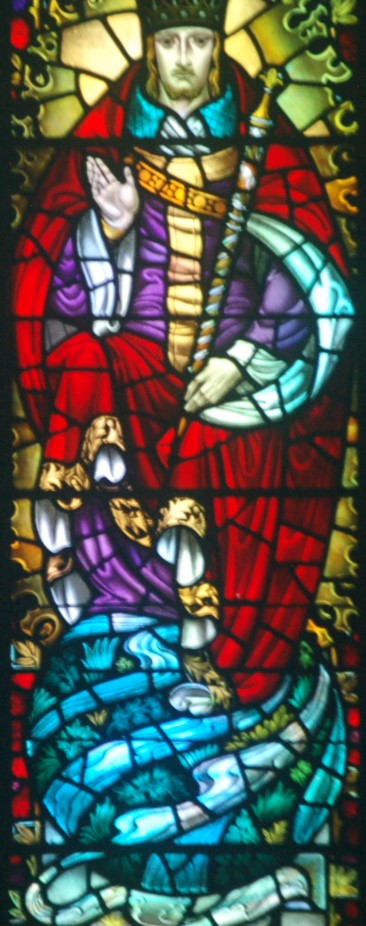
Jesus seated above the earth
The figure above is God the Father. The Greek letters alpha and omega are present, referring to Christ’s statement that he was the alpha and the omega, the first and the last (Alpha and omega are the first and last letters of the Greek alphabet.). God the Son is shown in the center as King of the world. He wears the crown of victory, holds the royal scepter, and is seated on the world as if on a throne. The almond-shaped mandorla surrounds him, a symbol of His glory. The Holy Spirit is again symbolized by the dove. The four evangelists, Matthew, Mark, Luke and John, are shown in the order their books appear in the New Testament.
- Matthew is symbolized by the angel, emphasizing Christ’s humanity.
- Mark is symbolized by the lion, emphasizing Christ’s royalty.
- Luke is symbolized by the ox, emphasizing Christ’s sacrificial offering.
- John is symbolized by the eagle, emphasizing Christ’s clarity of vision (the eagle was thought able to look directly at the sun without harm).
Additional symbols include Matthew’s money bags, sign of his occupation as tax collector, and the axes, instrument of his execution. Mark’s quill, ink, and keys show his occupation as secretary to St. Peter. St. Luke’s symbols are the physician’s staff and artist’s palette and brush. In medieval legends, St. Luke was described as being an artist and is often shown painting or drawing the Virgin and Child. St. John’s cup and serpent refer to a legendary event. St. John was forced to drink a cup of poison. In one account, the poison turned into a snake and crawled away. In another account, a serpent appeared and drank the poison before St. John could. Some other symbols are in the window, including the Christogram used by the early church as a disguised form of the cross and Christ’s and Mary’s monograms. The Christogram is made from the Greek letters chi (X) and rho (P), the first two letters in the Greek word for Christ. Christ’s monogram (IHS) is taken from the first three letters in Ihsus, the Latin spelling of Jesus.
Other Stained Glass
In the north narthex are four small windows representing the four prophets: Daniel, Ezekiel, Isaiah, and Jeremiah:
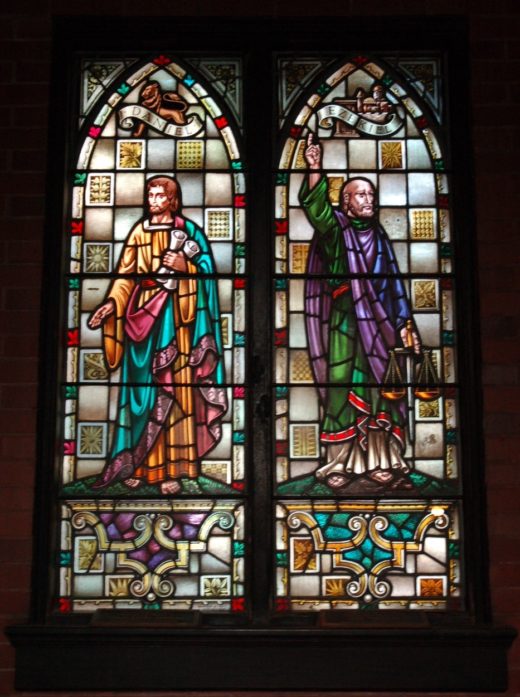
Daniel & Ezekiel 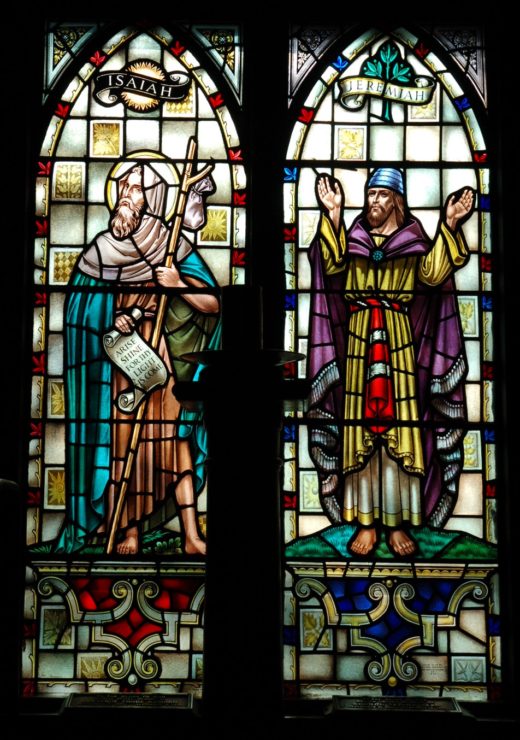
Isaiah & Jeremiah
In the west narthex are a window of St. Anne, the supposed mother of Mary, and the transom window featuring the symbols of the four canonical Gospels. The shield in the center of the Gospels bears a gold crown and the Latin word meaning holy, while the two smaller parts of this window bear a fleur-de-lys, a symbol with many connotations, including that of a lily (one of the symbols of the Virgin Mary).
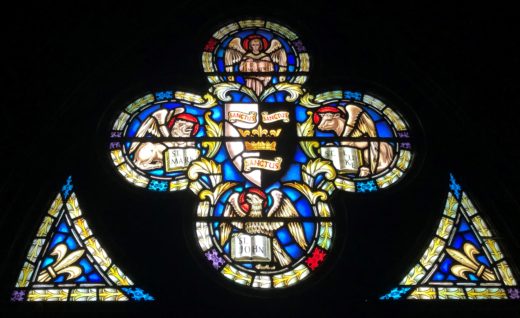
West transom window 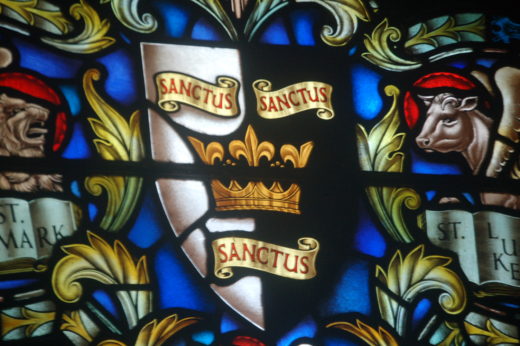
Holy, holy, holy
The transom over the door from the Church is listed as the window of All Saints.
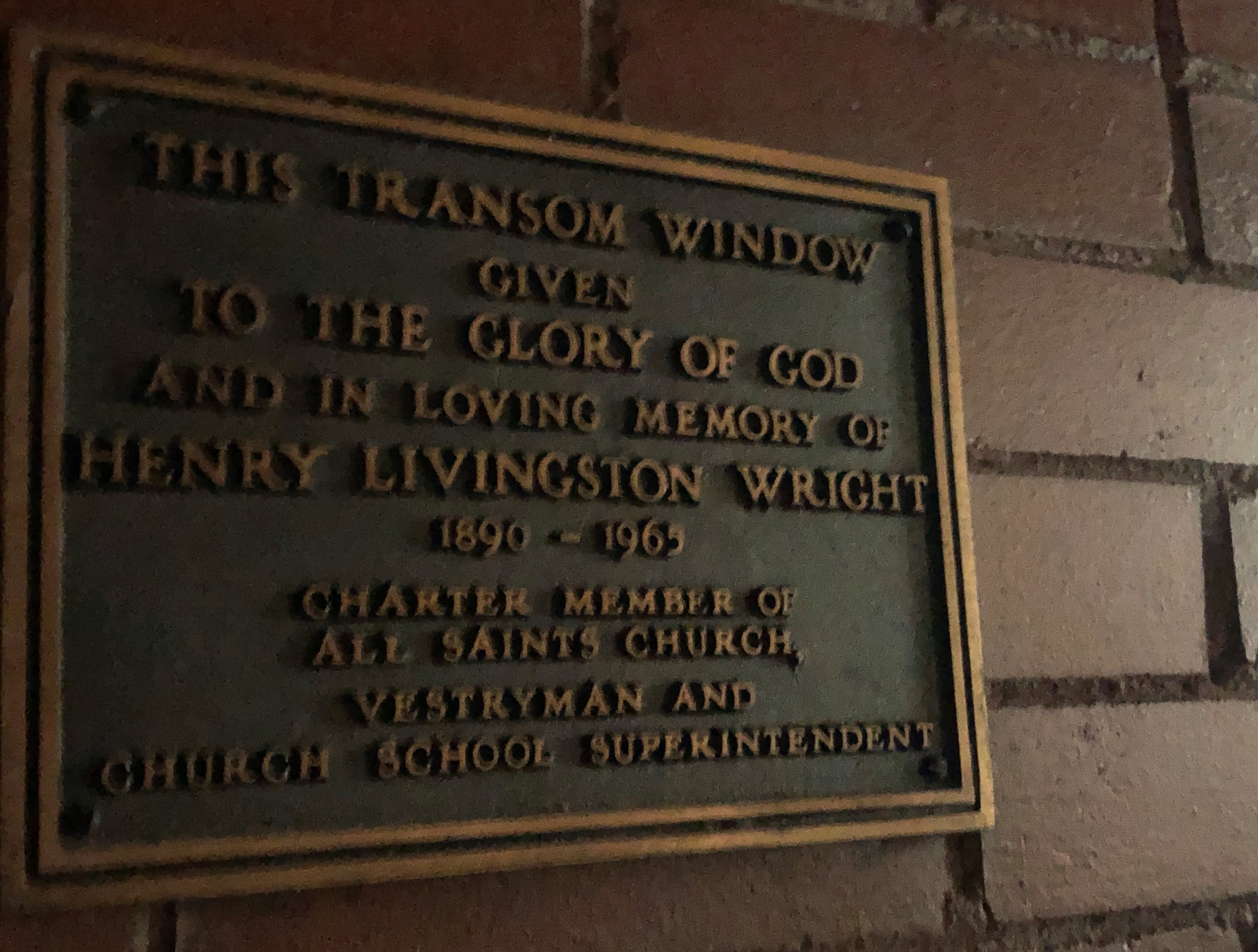
North transom memorial plaque
In the choir, above the organ on the north side, is St. Cecilia, the patron saint of music, who is often depicted with an organ. In this image she is surrounded by cherubim or putti. This window was donated in honor and thanksgiving for Miss Phoebe Lawrence, the first organist of All Saints, who continued service from 1910 into the 1960s or 1970s.
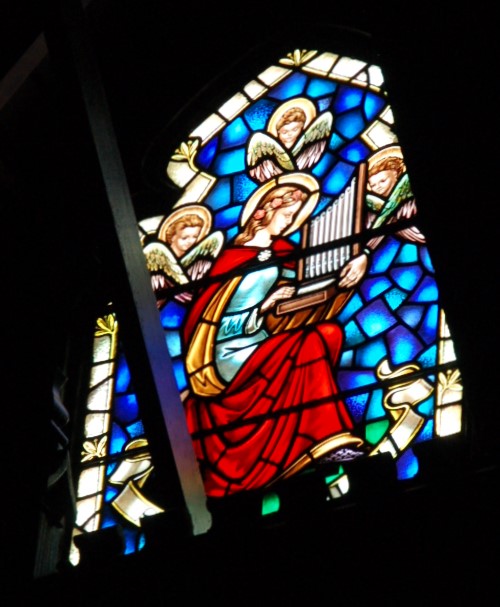
To the left of the altar is St. Barnabas. In medieval churches there was often a St. Barnabas gate to the left of the altar where the poor came to be served. This window is in memory of Thomas Reed Bridges (1868-1943):
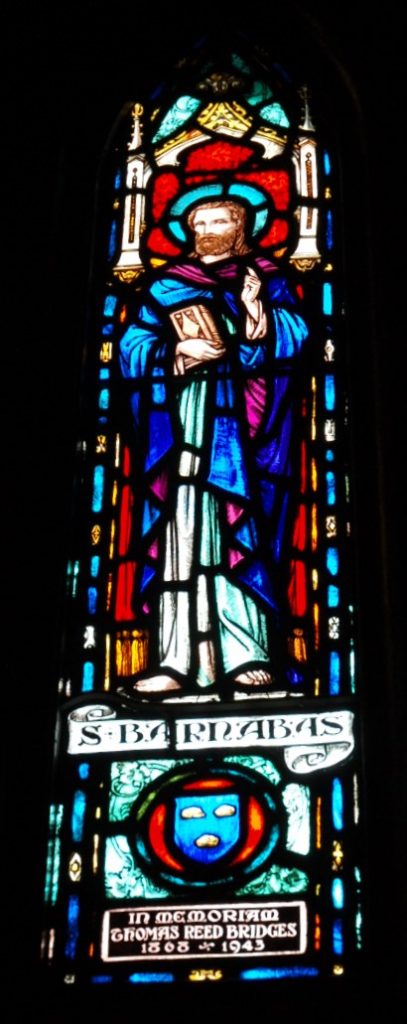
There are three “seraph” panels in our stained-glass windows. Can you find all 3?

